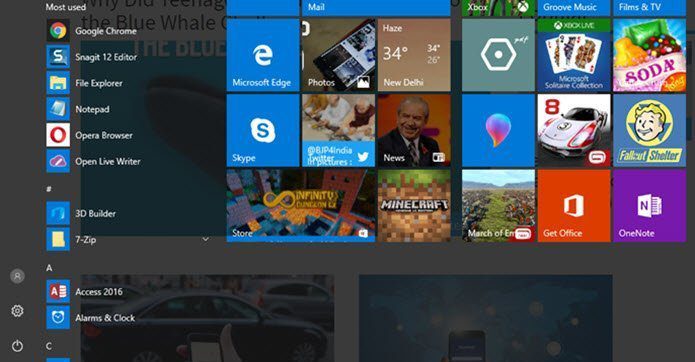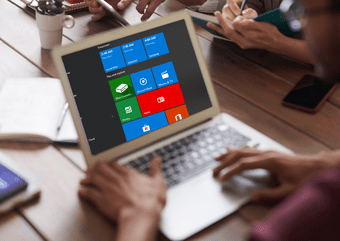Some users complain of noticing empty or blank icons in the Start Menu. Others say that they can’t see default Windows apps. Yet, some users are complaining that searching for specific installed apps yields no results. We will take a look at some possible solutions below that will address all these errors. Let’s begin.
1. Update Windows OS
If the error is related to some bug in the system files, you may resolve it by updating Windows 10. Press Windows key+I to open Settings and select Update & Security. Under Windows Update, you will see if there are any pending updates ready to download or install. You can also search for updates manually. Don’t forget to reboot your PC after installing any updates.
2. Update Apps
Since the error is related to apps directly, we will update all apps. Open Windows Store and click on the menu icon to find Downloads and update. If updates are already available and pending, you will see them separately as in the screenshot below. Click on Get updates to search for them and Update all to, well, update all apps. If you have apps that you can’t find in the Start Menu but were installed directly from a third-party site, there are two ways to update these apps. You can either search from within the app or visit the app download page for more details.
3. Scan for Virus
If you rely on Windows Defender, there is nothing else you need to do. It runs in the background and does its job. If you are using a third-party antivirus app, launch it, and perform a full scan. Follow on-screen instructions if it finds anything. I would recommend downloading Malwarebytes, which can work with any antivirus app without breaking anything. The free version is good enough. Again, do a full scan. You can also try Microsoft Safety Scanner app, which does a similar thing as Malwarebytes. Note that you will need to download the latest version once every 10 days. Download Microsoft Safety Scanner Download Malwarebytes
4. Troubleshoot
Windows 10 comes with a built-in Troubleshooting option that can be used to find errors in many Windows apps and services. Open the Start Menu and search for Find and fix problems with Microsoft Store Apps. If the search is not working here for this either, you can open Settings and search there. Select apply repairs automatically here and click on Next. Follow on-screen instructions from there.
5. Bloatware Apps
Microsoft ships Windows 10 with several apps pre-installed. While some of them are really good, others are not that much. These are also commonly referred to as bloatware. Some users found success by removing these unwanted, not so useful apps. You don’t want to remove or uninstall critical apps that will hamper the way Windows works. For example, Cortana. Usually, if an ‘uninstall’ option is available, it is safe to remove. Simply right-click on the app to select the Uninstall option. You can also go old school here and use Control Panel, especially if the app is not showing up or is missing in the Start Menu. Another way is to open Settings and go to Apps to uninstall them. Don’t forget to reboot your PC when done.
6. Reset / Repair Apps
Microsoft apps that ships with Windows OS have an option to repair them. It will attempt to repair corrupted files and remove errors. Some apps also have another option called Reset. That will reinstall the app, and all settings will revert to defaults. Note that your documents will not be touched. Skip to the next point for third-party apps. Open Settings by pressing the Windows key+I on your keyboard and click on Apps. Under Apps & features, find the app that is not showing up and click on it once to reveal Advanced options. Let’s say that the Calculator app is giving you trouble. Scroll a little to find the Reset and Repair option. Reboot if required and check if you can open the app from the Start Menu now. If yes, repeat the same process for all Microsoft apps that are not working.
7. Reinstall Apps
Following up on point 5 and 6, you will remove all affected apps, irrespective of where they were downloaded from, and reinstall them again. It can be the Windows Store or a third-party site. Make sure to take a backup of all data and even app settings if possible. You can also note important stuff in a note. Sometimes, when you uninstall an app, it leaves certain folders or files on the drive. You can usually find them in C drive under Program files or Users>Username>AppData>Local folder. Deleting these residual files will help do a clean install.
8. Clean Boot and Safe Mode
I have covered Clean Boot and Safe Mode in great detail here. Follow through and see if you can find irregularities using these two methods.
9. Re-register Apps
If a lot of apps are missing or not visible in the Start Menu or none of the above methods worked for you, you will need to re-register the apps. Search for and open Powershell. You can also open it from the hidden menu by pressing Windows key+X on your keyboard. Close all apps and windows, including My People to avoid errors. Type the below 4 commands one at a time. You should now see missing apps in the Start Menu, and the blank icons issue should be resolved.
10. SFC and DISM
SFC stands for System File Checker. A built-in tool that will attempt to find irregularities with Windows system files and repair them. Open Command Prompt with admin rights from the search or by pressing the Windows key+X shortcut. If you can’t find CMD, you can also open Powershell. Type the command below and hit Enter. Another command you can try is DISM. This command will attempt to restore Windows health by fixing corrupt files. If DISM finds anything, I recommend rerunning the SFC command. Reboot once everything is completed. These commands will take time to execute, so make sure to connect your laptops to their respective chargers before running them.
Start to Finish
The Start Menu plays an important role. It acts as a gateway to all the apps and program that are installed on our computer. Not being able to access it properly can be frustrating. Hopefully, one of the above solutions worked for you. Next up: Want to make the Start Menu transparent in Windows 10? Click on the link below to find out how. The above article may contain affiliate links which help support Guiding Tech. However, it does not affect our editorial integrity. The content remains unbiased and authentic.














![]()






